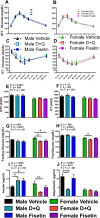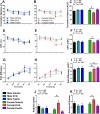Senolytic intervention improves cognition, metabolism, and adiposity in female APPNL-F/NL-F mice
- PMID: 39120687
- PMCID: PMC11872876
- DOI: 10.1007/s11357-024-01308-8
Senolytic intervention improves cognition, metabolism, and adiposity in female APPNL-F/NL-F mice
Abstract
Senescent cells accumulate throughout the body and brain contributing to unhealthy aging and Alzheimer's disease (AD). The APPNL-F/NL-F amyloidogenic AD mouse model exhibits increased markers of senescent cells and the senescence-associated secretory phenotype (SASP) in visceral white adipose tissue and the hippocampus before plaque accumulation and cognitive decline. We hypothesized that senolytic intervention would alleviate cellular senescence thereby improving spatial memory in APPNL-F/NL-F mice. Thus, 4-month-old male and female APPNL-F/NL-F mice were treated monthly with vehicle, 5 mg/kg dasatinib + 50 mg/kg quercetin, or 100 mg/kg fisetin. Blood glucose levels, energy metabolism, spatial memory, amyloid burden, and senescent cell markers were assayed. Dasatinib + quercetin treatment in female APPNL-F/NL-F mice increased oxygen consumption and energy expenditure resulting in decreased body mass. White adipose tissue mass was decreased along with senescence markers, SASP, blood glucose, and plasma insulin and triglycerides. Hippocampal senescence markers and SASP were reduced along with soluble and insoluble amyloid-β (Aβ)42 and senescence-associated-β-gal activity leading to improved spatial memory. Fisetin had negligible effects on these measures in female APPNL-F/NL-F mice while neither senolytic intervention altered these parameters in the male mice. Considering women have a greater risk of dementia, identifying senotherapeutics appropriate for sex and disease stage is necessary for personalized medicine.
Keywords: Alzheimer’s disease; Amyloid plaques; Cell senescence; Cognition; Dasatinib and quercetin; Fisetin.
© 2024. The Author(s).
Conflict of interest statement
Declarations. Competing interests: The authors declare no competing interests.
Figures






Update of
-
Senolytic Intervention Improves Cognition, Metabolism, and Adiposity in Female APP NL-F/NL-F Mice.bioRxiv [Preprint]. 2024 Jul 2:2023.12.12.571277. doi: 10.1101/2023.12.12.571277. bioRxiv. 2024. Update in: Geroscience. 2025 Feb;47(1):1123-1138. doi: 10.1007/s11357-024-01308-8. PMID: 38168356 Free PMC article. Updated. Preprint.
References
-
- Hardy JA, Higgins GA. Alzheimer’s disease: the amyloid cascade hypothesis. Science. 1992;256(5054):184–5. - PubMed
MeSH terms
Substances
Grants and funding
LinkOut - more resources
Full Text Sources
Medical

